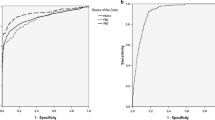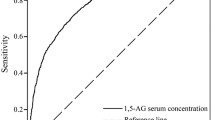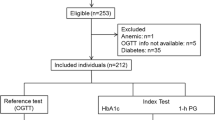Abstract
Aims
Previous studies indicated that urinary glucose (UG) had a limited efficacy in diabetes screening. This study was designed to have a re-evaluation of its efficacy, taking into consideration the collection method of urine and the measurement approach for UG among Chinese adults.
Methods
This cross-sectional study enrolled a total of 7689 participants without known diabetes, who were fasted and asked to empty bladders before a 75 g glucose loading. Urine was collected 2 h post glucose loading, and UG was measured using quantitative and qualitative approaches. The efficacy of UG in detecting diabetes was assessed by the receiver operating characteristic (ROC) curve.
Results
The area under the ROC curve was 0.89 for quantitative UG and 0.87 for qualitative UG. Quantitative UG was positively correlated with fasting plasma glucose (FPG) and 2 h plasma glucose (2 h PG) (r = 0.55 and 0.56, respectively, both P < 0.001). Quantitative UG displayed a sensitivity of 82.9% and a specificity of 84.7% in detecting diabetes at the corresponding optimal cutoff of 130 mg. Qualitative UG exhibited a sensitivity of 80.2% and a specificity of 85.6% at the optimal cutoff of glycosuria + 1. In addition, the sensitivity of both quantitative and qualitative UG was significantly higher than that of HbA1c (≥ 6.5%) (P < 0.001) and had a comparable sensitivity to 2 h PG (≥ 11.1 mmol/L) (P = 0.493).
Conclusions
UG, either quantitatively or qualitatively measured at 2 h post glucose loading, was effective in diabetes screening. This indicates that UG is a feasible approach for diabetes screening.


Similar content being viewed by others
References
Guariguata L, Whiting DR, Hambleton I et al (2014) Global estimates of diabetes prevalence for 2013 and projections for 2035. Diabetes Res Clin Pract 103:137–149. https://doi.org/10.1016/j.diabres.2013.11.002
Xu Y, Wang L, He J et al (2013) Prevalence and control of diabetes in Chinese adults. JAMA 310:948–959. https://doi.org/10.1001/jama.2013.168118
Laiteerapong N, Cifu AS (2016) Screening for prediabetes and type 2 diabetes mellitus. JAMA 315:697–698. https://doi.org/10.1001/jama.2015.17545
Yang W, Lu J, Weng J et al (2010) Prevalence of diabetes among men and women in China. N Engl J Med 362:1090–1101. https://doi.org/10.1056/NEJMoa0908292
Wild SH, Smith FB, Lee AJ, Fowkes FG (2005) Criteria for previously undiagnosed diabetes and risk of mortality: 15-year follow-up of the Edinburgh Artery Study cohort. Diabet Med 22:490–496. https://doi.org/10.1111/j.1464-5491.2004.01433.x
da RFJ, Ogurtsova, Linnenkamp K, Guariguata U et al (2016) IDF Diabetes Atlas estimates of 2014 global health expenditures on diabetes. Diabetes Res Clin Pract 117:48–54. https://doi.org/10.1016/j.diabres.2016.04.016
Wang W, Lee ET, Fabsitz R, Welty TK, Howard BV (2002) Using HbA(1c) to improve efficacy of the american diabetes association fasting plasma glucose criterion in screening for new type 2 diabetes in American Indians: the strong heart study. Diabetes Care 25:1365–1370
Deepa R, Shanthi RS, Premalatha G, Mohan V (2000) Comparison of ADA 1997 and WHO 1985 criteria for diabetes in south Indians—the Chennai Urban Population Study. American Diabetes Association. Diabet Med 17:872–874
Zhou X, Pang Z, Gao W et al (2010) Performance of an A1C and fasting capillary blood glucose test for screening newly diagnosed diabetes and pre-diabetes defined by an oral glucose tolerance test in Qingdao, China. Diabetes Care 33:545–550. https://doi.org/10.2337/dc09-1410
Li-nong J, Wei L, Wei L et al (2010) Impact of newly recommended HbA1c-based diabetes diagnostic criteria on the prevalence of diabetes and high risk individual in clinical and community population in China. Chin Med J (Engl) 123:1103–1104
Sun X, Du T, Huo R, Xu L (2014) Hemoglobin A1c as a marker for identifying diabetes and cardiovascular risk factors: the China Health and Nutrition Survey 2009. Acta Diabetol 51:353–360. https://doi.org/10.1007/s00592-013-0515-5
World Health Organization (2003) Screening for type 2 diabetes: report of a World Health Organization and International Diabetes Federation meeting. http://www.who.int/diabetes/publications/screening2003/en/. Accessed 1 Jan 2018
Davies MJ, Williams DR, Metcalfe J, Day JL (1993) Community screening for non-insulin-dependent diabetes mellitus: self-testing for post-prandial glycosuria. Q J Med 86:677–684
Hanson RL, Nelson RG, McCance DR et al (1993) Comparison of screening tests for non-insulin-dependent diabetes mellitus. Arch Intern Med 153:2133–2140
Friderichsen B, Maunsbach M (1997) Glycosuric tests should not be employed in population screenings for NIDDM. J Public Health Med 19:55–60
Miyashita M, Ito N, Ikeda S et al (2009) Development of urine glucose meter based on micro-planer amperometric biosensor and its clinical application for self-monitoring of urine glucose. Biosens Bioelectron 24:1336–1340. https://doi.org/10.1016/j.bios.2008.07.072
Ruhnau B, Faber OK, Borch-Johnsen K, Thorsteinsson B (1997) Renal threshold for glucose in non-insulin-dependent diabetic patients. Diabetes Res Clin Pract 36:27–33
Rave K, Nosek L, Posner J et al (2006) Renal glucose excretion as a function of blood glucose concentration in subjects with type 2 diabetes—results of a hyperglycaemic glucose clamp study. Nephrol Dial Transpl 21:2166–2171. https://doi.org/10.1093/ndt/gfl175
Lu J, Bu RF, Sun ZL et al (2011) Comparable efficacy of self-monitoring of quantitative urine glucose with self-monitoring of blood glucose on glycaemic control in non-insulin-treated type 2 diabetes. Diabetes Res Clin Pract 93:179–186. https://doi.org/10.1016/j.diabres.2011.04.012
Urakami T, Kubota S, Nitadori Y et al (2005) Annual incidence and clinical characteristics of type 2 diabetes in children as detected by urine glucose screening in the Tokyo metropolitan area. Diabetes Care 28:1876–1881
Restrepo BI, Pino PA, Zarate I, Mora-Guzman F (2013) Dipstick urinalysis for diabetes screening in TB patients. Int Health 5:157–159. https://doi.org/10.1093/inthealth/iht007
Yang BQ, Lu Y, He JJ et al (2015) Performance of fasting plasma glucose and postprandial urine glucose in screening for diabetes in chinese high-risk population. Chin Med J (Engl) 128:3270–3275. https://doi.org/10.4103/0366-6999.171353
Kim MS, Lee DY (2017) Urinary glucose screening for early detection of asymptomatic type 2 diabetes in Jeonbuk Province Korean Schoolchildren. J Korean Med Sci 32:985–991. https://doi.org/10.3346/jkms.2017.32.6.985
Malhotra RK, Indrayan A (2010) A simple nomogram for sample size for estimating sensitivity and specificity of medical tests. Indian J Ophthalmol 58:519–522. https://doi.org/10.4103/0301-4738.71699
Khunti K, Gillies CL, Taub NA et al (2012) A comparison of cost per case detected of screening strategies for Type 2 diabetes and impaired glucose regulation: modelling study. Diabetes Res Clin Pract 97:505–513. https://doi.org/10.1016/j.diabres.2012.03.009
Bao Y, Ma X, Li H et al (2010) Glycated haemoglobin A1c for diagnosing diabetes in Chinese population: cross sectional epidemiological survey. BMJ 340:c2249
Gerich JE (2010) Role of the kidney in normal glucose homeostasis and in the hyperglycaemia of diabetes mellitus: therapeutic implications. Diabet Med 27:136–142. https://doi.org/10.1111/j.1464-5491.2009.02894.x
Qiao Q, Nakagami T, Tuomilehto J et al (2000) Comparison of the fasting and the 2-h glucose criteria for diabetes in different Asian cohorts. Diabetologia 43:1470–1475. https://doi.org/10.1007/s001250051557
Jia WP, Pang C, Chen L et al (2007) Epidemiological characteristics of diabetes mellitus and impaired glucose regulation in a Chinese adult population: the Shanghai Diabetes Studies, a cross-sectional 3-year follow-up study in Shanghai urban communities. Diabetologia 50:286–292. https://doi.org/10.1007/s00125-006-0503-1
Sun Z, He J, Qiu S et al (2015) Using serum advanced glycation end products-peptides to improve the efficacy of World Health Organization fasting plasma glucose criterion in screening for diabetes in high-risk chinese subjects. PLoS One 10:e0137756. https://doi.org/10.1371/journal.pone.0137756
Katulanda P, Hill NR, Stratton I et al (2016) Development and validation of a diabetes risk score for screening undiagnosed diabetes in Sri Lanka (SLDRISK). BMC Endocr Disord 16:42. https://doi.org/10.1186/s12902-016-0124-8
Zhang L, Zhang Z, Zhang Y, Hu G, Chen L (2014) Evaluation of Finnish Diabetes Risk Score in screening undiagnosed diabetes and prediabetes among U.S. adults by gender and race: NHANES 1999–2010. PLoS One 9:e97865. https://doi.org/10.1371/journal.pone.0097865
Stride A, Ellard S, Clark P et al (2005) Beta-cell dysfunction, insulin sensitivity, and glycosuria precede diabetes in hepatocyte nuclear factor-1alpha mutation carriers. Diabetes Care 28:1751–1756
Ottosson-Laakso E, Tuomi T, Forsén B et al (2016) Influence of familial renal glycosuria due to mutations in the SLC5A2 gene on changes in glucose tolerance over time. PLoS One 11:e0146114. https://doi.org/10.1371/journal.pone.0146114
Nagai K, Yoshida S, Konishi H (2014) Gender differences in the gene expression profiles of glucose transporter GLUT class I and SGLT in mouse tissues. Pharmazie 69:856–859
Sabolic I, Vrhovac I, Eror DB et al (2012) Expression of Na+-d-glucose cotransporter SGLT2 in rodents is kidney-specific and exhibits sex and species differences. Am J Physiol Cell Physiol 302:C1174–C1188. https://doi.org/10.1152/ajpcell.00450.2011
Teixeira SD, Panveloski-Costa AC, Carvalho A et al (2016) Thyroid hormone treatment decreases hepatic glucose production and renal reabsorption of glucose in alloxan-induced diabetic Wistar rats. Physiol Rep. https://doi.org/10.14814/phy2.12961
Patel S, Fraser A, Davey SG et al (2012) Associations of gestational diabetes, existing diabetes, and glycosuria with offspring obesity and cardiometabolic outcomes. Diabetes Care 35:63–71. https://doi.org/10.2337/dc11-1633
Klein P, Polidori D, Twito O, Jaffe A (2014) Impaired decline in renal threshold for glucose during pregnancy—a possible novel mechanism for gestational diabetes mellitus. Diabetes Metab Res Rev 30:140–145. https://doi.org/10.1002/dmrr.2474
Acknowledgements
We owe our sincere thanks to the local research teams and colleagues for assistance in participant recruitment. We are grateful to many residents of Jiangsu Province who participated in this study. We thank all the staff who were involved in this study for their important contributions.
Funding
This work was supported by a grant from the National Key R&D Program of China (2016YFC1305700), the National Key Scientific Instrument and Equipment Development Project of China (No. 51627808) and the Key Program for Clinical Medicine and Science and Technology, Jiangsu Province, China (BL2014079).
Author information
Authors and Affiliations
Corresponding author
Ethics declarations
Conflict of interest
The authors declare that they have no conflict of interest.
Ethical approval
All procedures performed in studies involving human participants were in accordance with the ethical standards of Jiangsu Provincial Center for Disease Control and Prevention and Zhongda Hospital, Southeast University and with the 1964 Helsinki Declaration and its later amendments.
Informed consent
Informed consent was obtained from all participants included in the study.
Data availability
Data are available from the corresponding author for researchers who meet the criteria for access to confidential data. Please contact Zilin Sun (email: sunzilin1963@126.com).
Additional information
Managed by Massimo Federici.
Rights and permissions
About this article
Cite this article
Chen, J., Guo, H., Yuan, S. et al. Efficacy of urinary glucose for diabetes screening: a reconsideration. Acta Diabetol 56, 45–53 (2019). https://doi.org/10.1007/s00592-018-1212-1
Received:
Accepted:
Published:
Issue Date:
DOI: https://doi.org/10.1007/s00592-018-1212-1




